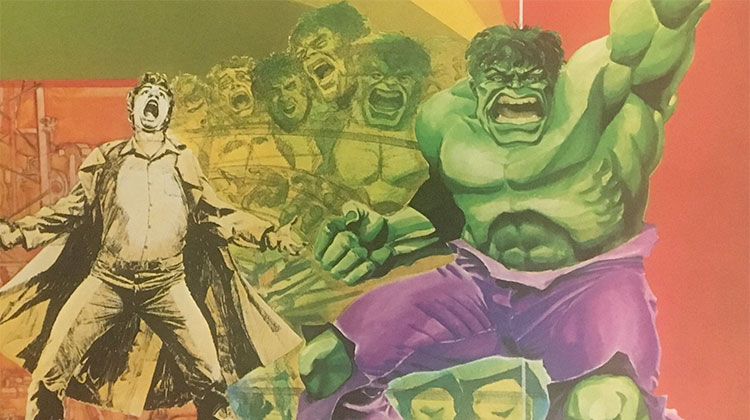
by Michael Sangiacomo
ROCKY RIVER – Valentino Zullo said the first reference to homosexuality in his beloved superhero comics was negative.
“It was an issue of The Hulk from 1980 which explained that the Hulk’s alter-ego, Bruce Banner, was almost raped by two men in a YMCA,” Zullo said. “That’s a pretty harsh way to introduce the subject to a mainstream audience.”
It didn’t get any better in 1988 when DC Comics introduced the first openly gay character in mainstream comics, Extrano, a flamboyant Peruvian in the New Guardians comic who embodied “every gay stereotype possible.”
But things have improved.
Zullo, 30, of Shaker Heights, recently talked about the history of gays in comics at the Rocky River Library in honor of Pride month. Zullo is a doctoral candidate at Kent State University who leads comic-related programs at the Cleveland Public Library.
Zullo said when he came out as gay 15 years ago, such programs did not exist.
Today, gay characters are as common in comics and graphic novels as they are on television and in the movies. They are even popular in superhero comics. Zullo said they offer the concept of acceptance to gay readers that he could not find as a youth.
“Batwoman was introduced in 2006 as openly gay,” he said. “Catwoman is officially bisexual. There are gay members on many of the teams in comics from every company. In fact, in Young Avengers the character Hawkeye wondered if he was the only straight person on the team”
Even Snagglepuss, the beloved Hanna Barbara cartoon character who appears in DC comics is openly gay. And Jughead, of Archie Comics fame, recently declared that he is asexual, with no sexual preference at all.
In the 1940s, there were characters that flirted with sexual issues. Ma Hunkel was a woman who dressed as the male superhero Red Tornado in All-American Comics #20; Wonder Woman came from an island populated only by women, leading some to speculate about her sexual preference. One of her early adversaries is the Blue Snowman, a woman who disguised herself as a man.
There are other beloved characters that push the sexual envelope. “Bugs Bunny for one,” said Zullo. “How many times did Bugs and the other cartoon characters pose as females?”
The first serious attempt to portray gays in comics did not come from mainstream books, but from the so-called “underground comix” of the late 1960s and early 1970s. These comics often told realistic tales of gay and lesbian life, often in graphic detail.
The first openly gay, mainstream superhero in comics was Northstar, a super-speedster affiliated with Alpha Flight, the X-Men of Canada. But it was a half-hearted effort from Marvel Comics.
After years of hints of his sexual preference, the character finally came out in 1992. Marvel almost immediately backed off the declaration. In a Northstar mini-series that soon followed his sexual preference was barely noted.
As the years passed, Northstar (and Marvel) embraced his sexuality. In 2012, he became the first superhero to marry a member of his own sex.
Today there are many graphic novels that examine the gay lifestyle, many doing so without being sexually explicit. Laura Dean Keeps Breaking Up With Me by Mariko Tamaki and On a Sunbeam by Tillie Walden are just two recent examples, and the anthology No Straight Lines, edited by Justin Hall provides an overview of the last 40 years of LGBTQ comics.
Zullo said it is important that everyone be able to identify with characters in literature, whether they are gay, straight, minority, or even disabled. Everyone should have a voice.
(Editor’s Note: the above-referenced Hulk story was a complete revelation to me; as an avid 10-year-old Hulk reader in 1980, I couldn’t have missed something so shocking, could I? Not in those halcyon days of peaceful, tranquil 1980!
Before you go scouring through your back issues as I did, a quick google search will lead you to Hulk Magazine #23, which features “A Very Personal Hell,” by Jim Shooter and John Buscema. The Marvel Magazine line was meant for more mature readers, but unlike modern comics, came with no parental ratings. Viewed today, the story is an interesting example of how homosexuality was addressed at that time, and worthy of a few moments of reflection about how we have, and perhaps unfortunately, haven’t changed.
We have one copy of the book in the shop; I’ll keep it around if anyone would like to stop in and give it a read. The second story in the book is just as weird and perplexing and mostly focuses on a housewife hitting on Bruce Banner. More mature, indeed!)
Michael Sangiacomo can be reached at mikesang@aol.com. The Editor can be reached at the shop, just about all day every day.
Leave a Reply